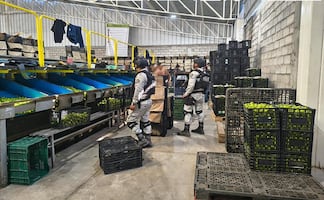Más Información

FGR investiga caja negra del Tren Interoceánico y concluye necropsias; despliega peritos en 13 especialidades

A 50 días del Plan Michoacán, detienen a 278 personas; realizan recorridos a empacadoras e industrias cítricas

Prueba piloto para afiliar a trabajadores de plataformas digitales aún no termina, explica IMSS; acciones continúan, dice

Detienen y vinculan a proceso Alejandro Baruc “N” en Uruapan, Michoacán; podría estar relacionado con el asesinato de Carlos Manzo

Emiten alerta en seis estados por robo de cilindro con gas cloro; advierten por alto nivel de toxicidad
The Mexico Public Registration of Archaeological and Historical Monuments and Zones has registered 1,709 archeological vestiges in the route planned for the Mayan Train , a number that will certainly increase with the studies held in the route, according to the National Institute of Anthropology and History (INAH).
The registered vestiges until now are distributed in the states of Yucatán (649), Campeche (481), Tabasco (295), Quintana Roo (142), and Chiapas (142) .
“There are from small Mayan homesteads to more relevant structures , cenotes , fields of ceramic debris,” said to EFE Pedro Francisco Sánchez Nava , national coordinator of Archeology of the INAH .
Among the archeological sites potentially affected are distinguished, for one part, those that are open to the public , and for the other, those that are not tourism destinations . Besides, there would be 24 cenotes that are assumed to contain archeological vestiges.
Most of the registered sites currently correspond to the more superficial archeological levels , but some cenotes could have fauna vestiges from the Pleistocene, a geological era that extends from approximately 2.6 million to 11,700 years.
In addition, the research is expected to show data from different eras .
To obtain these data, 15 kilometers of each side of the route of the Mayan Train will be covered, a margin that would be linked with the space that the “ collateral or induced works ” of such infrastructure would need, like stations, camps, access roads, or electrical installations .
When the potential vestiges are analyzed , alternatives for their management will be posed, like the consolidation and preservation of the vestige underground, its integration in the space, or the obstruction of any action in it, depending on the heritage relevance of what is found.
“There’s an evaluation by the INAH to classify these remains on those of less relevance , which could be moved without having to change the route, and others that would actually require the alteration of the path of the train,” said to EFE the vice-president of Studies and Projects of the Mayan Train of the National Fund for Tourism Development (FONATUR), Juan Javier Carrillo .
Different techniques will be used to assess the importance of the remains, like satellite images , drone flights , or LIDAR technology , with which a surface of 38,414 square kilometers will be covered
In LIDAR technology “a manned aircraft equipped with a laser projector” is used. When the beam is projected, it bounces on the surface of the earth and is captured by a sensor that determines the distance to a certain point. By performing “different pulses of laser in the same strip… a net of dots over the surface of the earth” is achieved, stated Carrillo .
According to Carrillo, more than 10,000 shots of laser per second could be pulsed, with “such a power that it could penetrate through the leaves and impact the surface of the earth .”
Enough information to get a “very precise” topographic configuration of the land will be obtained.
“For the expert eye of an archeologist, that will allow observing certain shapes , with defined geometries that would not seem of natural origin, and that would offer a first hint of what could be an archeological vestige ,” he said.
Nowadays, calculations are performed to “evaluate the real cost ” of the use of LIDAR technology , although in FONATUR they estimate that, for the total route of the Mayan Train, the amount could exceed the MXN $70 million .
FONATUR
will deliver the results of the use of this technology to the INAH so that the institute performs the subsequent archeological prospection .
The Mayan Train is an ambitious infrastructure with which President Andrés Manuel López Obrador proposes to push the development of the impoverished southeast of the country.
The project considers the laying of more than 1,500 kilometers of tracks through the states of Tabasco, Chiapas, Campeche, Yucatán, and Quintana Roo, with an expected investment of USD $7,389 million , that will include public and private funding.
“The Mayan Train is a cultural corridor , a strategic project of this administration, which has the objective of giving a space of dignity , acknowledgment, and strength to one of the most important cultures that precede us and that is still alive,” declared on her moment the secretary of Culture, Alejandra Frausto .
However, different sectors – like ecologist organizations – have warned of the possible negative effects this initiative could have in different aspects like ecosystems or the archeological richness of the region.
Noticias según tus intereses
[Publicidad]
[Publicidad]











